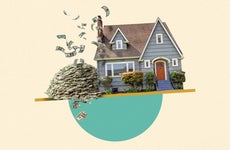How are mortgage rates determined?

The Bankrate promise
At Bankrate we strive to help you make smarter financial decisions. While we adhere to strict , this post may contain references to products from our partners. Here's an explanation for .
Key takeaways
- Mortgage rates are affected by market factors like inflation, the cost of borrowing, bond yields and risk.
- Mortgage rates are also affected by personal financial factors, such as your down payment, income, assets and credit history.
Mortgage rates have thrown Americans for a wild ride in recent years, plunging to record lows during the pandemic and then nearly tripling, to just over 8 percent in October 2023. Since then, they’ve fallen and stabilized, with the benchmark 30-year fixed mortgage hovering between 6.5 and 7.3 percent so far this year. Bankrate forecasts they’ll eventually decline further, though the timing remains uncertain.
But what influences mortgage rates in the first place? From global financial markets to your personal portfolio of accounts, here’s how mortgage rates are determined.
How are mortgage interest rates determined?
It may seem like mortgage interest is dictated by lenders: They’re the ones advertising the rates, right? But actually, mortgage rates “are not directly set by any one entity but rather arise from the interplay of complex economic factors,” says Andrew Latham, a certified financial planner based in Rolesville, North Carolina. “Lenders typically set their rates based on the return they need to make a profit after accounting for risks and costs.”
That said, they don’t just pluck numbers out of the air. A mortgage loan is debt, and for context, lenders look to another type of debt: bonds. “When investors purchase bonds, they are essentially lending money in exchange for periodic interest payments and a return of the principal when the bond matures,” says Dennis Shirshikov, head of growth at vacation home platform Summer.com and former adjunct professor of economics and finance at City University of New York. The annual rate of return a bond offers investors, reflecting its price and its interest rate, is known as its yield. “Mortgage rates are heavily influenced by these [bond] yields,” he says.
There are many types of bonds, but lenders focus on mortgage-backed securities (MBS). Their rates are closely tied to those of U.S. Treasury bonds (T-bonds), particularly the 10-year Treasury note.
“Mortgage-backed securities usually trade at an interest rate premium to the T-bonds, and this difference between Treasury rates and MBS rates is called the mortgage spread,” says Preetam Purohit, head of hedging and analytics for Embrace Home Loans. “Mortgage lenders usually add a margin to the MBS rate to come up with the rate they charge for a mortgage loan.
“Banks that [originate] mortgage loans, on the other hand, use a different mechanism to set their own mortgage rates because they can retain loans on their balance sheets. They usually use a cost of funds plus bank margin approach to set their own mortgage rates,” he adds.
Market factors impacting mortgage interest rates
Of course, bonds don’t perform in a vacuum; their “yield is influenced by the state of the economy, inflation, Federal Reserve policy and investor sentiment, among other things,” says Shirshikov. So these various market elements ultimately affect mortgage rates, too. Among them:
The economy
What happens in the economy – and how those events affect investors’ confidence – influences mortgage pricing. Good and bad economic news has an inverse impact on the direction of mortgage rates. Mortgage rates tend to increase when the national economy is robust and job growth is high. This is partly a result of where investors decide to put their money; if they find more attractive returns elsewhere, the bond market will need to increase interest rates to compete, which results in costlier rates for borrowers. “Conversely, during economic downturns, mortgage rates tend to decline as money flows from more risky investments to more stable investments like mortgages,” says Scott Bridges, senior managing director for Pennymac, a national mortgage lender.
Inflation
Inflation, the increase in the pricing of goods and services over time, is an important benchmark when measuring economic growth. Rising inflation limits consumers’ purchasing power, and that’s a consideration lenders make when setting mortgage rates. Lenders must adjust mortgage rates to a level that makes up for eroded purchasing power when inflation rises too quickly. After all, lenders still need to make a profit on the loans they originate, and that becomes more difficult when consumers’ buying power is diminished. Likewise, inflation is a consideration investors make in the returns they demand on mortgages and other bonds they purchase on the secondary market. When inflation is elevated, investors commonly pursue investments that can beat or match its climb. This intensified demand for high yields means less-preferable mortgage rates for consumers.
The Federal Reserve
The Federal Reserve doesn’t set mortgage rates, but its monetary policy decisions definitely influence them. “The Fed can raise or lower short-term interest rates, which indirectly affects mortgage rates. When the Fed raises rates, it becomes more expensive for banks and lenders to borrow money; this translates to increased rates for borrowers. When the Fed lowers rates, it becomes cheaper to borrow money, resulting in lower mortgage rates,” says Bridges. For example, as the Fed began hiking interest rates in 2022 in an effort to squelch inflation, mortgage rates rose too — first in anticipation of, and then in response to, the central bank’s moves.
Financial markets
The performance of T-bonds and mortgage-backed securities plays a role in your mortgage’s interest rate. “Because mortgages are packaged together into securities and sold as mortgage bonds, it’s the return investors demand to buy these bonds that dictates the general level of mortgage rates,” says Greg McBride, CFA, Bankrate’s chief financial analyst. Mortgage rate levels are priced above that of the 10-year Treasury; the spread between them reflects the risk investors bear for holding those bonds. “It may seem counterintuitive that 30-year mortgage rates are priced relative to yields on 10-year Treasuries,” says McBride, “but when these 30-year mortgages are packaged together into bonds, on average, they tend to pay out over a 10-year period as homeowners refinance, move or otherwise pay off their loans early.”
Government policies
If the federal government implements policies that promote homeownership, such as down payment assistance or tax credits, it can stimulate demand for mortgages and possibly lead to higher rates.
Global and/or political events
World events like war, pandemic, or major election can influence the U.S. stock and bond markets in similar ways, which tend to directly influence mortgage rates on the whole.
Political unrest abroad can drive investments stateside – and with an increased demand comes higher prices, which lowers the rate of return. “A financial crisis in another country, for example, could send investors flocking to U.S. bonds as a safe haven, driving down their yields and, in turn, mortgage rates,” says Shirshikov.
Personal factors impacting mortgage interest rates
We’ve talked so far about what drives mortgage rates in general. When it comes to an individual loan, your financial and credit status can also affect the mortgage interest rate you personally qualify for. In particular:
- Credit score. A higher credit score can earn you a lower mortgage rate. Lenders want confidence that you can and will repay your mortgage. Your credit score is perhaps the most crucial criterion in deciding your creditworthiness — that is, how likely you are to default on the loan. Borrowers with lower credit scores pay higher interest rates and have more limited loan options. A good FICO credit score is technically any score of 670 or above.
- Loan-to-value (LTV) ratio. The LTV ratio compares your loan amount to the property’s price. A lower LTV ratio typically results in a lower mortgage rate. Your down payment will dictate your LTV ratio; the more you put down (a 20 percent down payment equates to an 80 percent LTV ratio), the lower your LTV ratio and the less of a risk to the lender.
- Debt-to-income (DTI) ratio. Your DTI ratio is the sum of all of your monthly debt payments divided by your gross monthly income, which signifies your financial stability and capacity to manage debt and afford your loan. Generally, the higher your DTI ratio, the riskier you appear to a lender — and the higher your interest rate will be. Most conventional loans allow for a DTI of no more than 45 percent. Still, some lenders will accept ratios as high as 50 percent depending on a borrower’s circumstances, such as a savings account with a balance equal to six months’ worth of housing expenses. Aiming for a DTI of 36 percent or less is best for competitive rates.
- Loan amount. If you can make a significant down payment and have a good DTI ratio, you may get a lower rate with a larger loan. The flip side is also true—if you’re pushing the limits with your purchase, you’ll likely get a higher rate.
- Closing costs. What and when you pay in closing costs can also dictate your rate. Case in point: If you opt not to pay these fees upfront but roll them into the loan itself, the lender may charge a slightly higher mortgage rate.
- Discount points. You pay these optional extra fees upfront to the lender at closing in exchange for a lower mortgage rate. In a sense they are prepaid interest.
- Property type. “Occupancy status, such as if this will be your primary home, secondary home or investment property, can also significantly impact the rate. If the home will be your primary residence, the rate may be lower,” says Purohit. “The type of property will also impact the rate. Any property type other than a single-family home — such as a condo, manufactured home, or multi-unit dwelling — will generally increase the mortgage rate.”
How much do mortgage rates vary across lenders?
Mortgage interest rates can vary substantially from lender to lender. This is due to differences in their pricing strategies, cost structures, margins and risk appetites.
“Some lenders may specialize in certain types of borrowers and loans, which influences their pricing. Moreover, lender fees and costs like discount points can also alter your rate,” says Latham.
The cost of originating mortgages includes tasks such as running a credit check, underwriting, performing a title search and completing the many other steps a lender must take to process a loan. “In setting prices, lenders have to look at the cost of origination and decide what margins they want above those costs,” says Jerry Selitto, president of Better.com, an online mortgage lender. “The more efficient a manufacturer of mortgages can be, the more competitive they are on pricing.”
Competition in the local market can make a difference here, too. “An area with higher competition between lenders leads to compressed margins and lower mortgage rates,” says Purohit.
How different mortgage loan types can have different interest rates
In addition to mortgage loan rates varying between lenders, different types of mortgage products have different rates.
“This is due to variations in term length, risk and market demand,” says Latham. “For instance, fixed-rate mortgages often charge a higher interest rate than adjustable-rate mortgages during the ARM’s fixed-rate period because lenders of fixed-rate loans bear the risk of interest rate changes during the loan’s term.”
However, once the ARM rate adjusts — often after the first one to five years – the rate can fluctuate up or down, possibly rising substantially.
“Also, government-backed loans like FHA, VA and USDA mortgage loans often charge lower rates because the government guarantees these loans, which reduces the risk for the lender offering the loan,” says Latham.
How to estimate your mortgage rate
There are several personal factors that affect your mortgage rate. They are:
- Your credit score
- Your home’s location
- The home price and loan amount
- Your down payment
- The type of loan and its length
- Whether it’s a fixed- or adjustable-rate mortgage
Once you know these factors, you can understand where you may fall in terms of qualifying for a mortgage. You can then play with the rate on Bankrate’s mortgage calculator to get a good idea of what your monthly payment will be.
The bottom line on what drives mortgage rates
“It’s the longer-term outlook for economic growth and inflation that have the greatest bearing on the level and direction of mortgage rates,” says McBride. “Inflation, inflation, inflation — that’s really the hub on the wheel.”
Knowing more about what drives mortgage rates, who controls mortgage rates, and how rates can vary depending on the lender and loan product can make you a better-informed borrower. But trying to time the market is generally a bad idea. If buying a house is the right move for you now, don’t stress about trends or economic outlooks. Start shopping around for financing.
Frequently asked questions about mortgage rates
-
Mortgage rates can fluctuate daily, based on various factors like changes in the broader financial market, economic indicators and investor sentiment. Mortgage rates are closely tied to the yields on government bonds, in particular the 10-year Treasury note. If you are shopping for a mortgage loan and are concerned that rates will go higher in the months or weeks ahead, it can be smart to lock in a fixed rate now. Or, you might want to choose an adjustable-rate mortgage (ARM) if you expect you won’t remain in your home past the loan’s initial fixed-rate period or you believe that mortgage rates will drop in the near future and you plan to refinance to a new fixed-rate loan.
-
To improve your chances of being quoted a lower mortgage interest rate, the experts recommend improving your credit score by:
- Paying your bills on time
- Paying off outstanding balances
- Not opening new credit accounts or taking on other big debts
Related Articles



